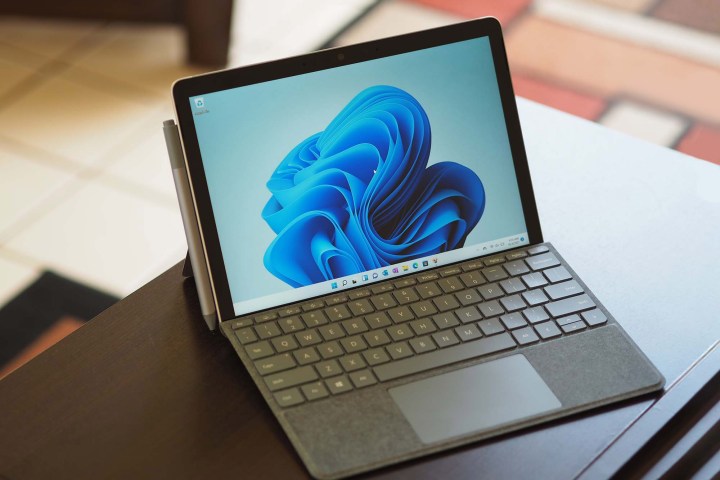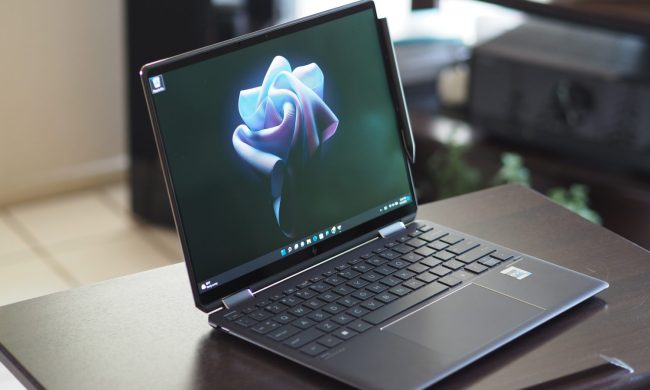There’s something to be said about the best small tablets with detachable keyboards. They’re easier to carry around than full-size tablets while still larger than smartphones, so they’re perfect for web browsing and media consumption. You can even get real work done on them. Apple’s iPad established the model, but what if you don’t like iPad OS? That’s where Chrome OS and Windows come in.
Microsoft’s Surface Go 3 is the best miniature Windows 11 tablet you can buy, while Chrome OS finally has a contender in the HP Chromebook x2 11. Both have their charms, but which is the better small detachable tablet?
Specs
| HP Chromebook x2 11 | Microsoft Surface Go 3 | |
| Dimensions | 9.94 inches x 6.96 inches x 0.3 inches | 9.65 inches x 6.9 inches x 0.33 inches |
| Weight | 1.23 pounds (tablet) | 1.2 pounds (tablet) |
| Processor | Qualcomm Snapdragon 7c | Intel Pentium Gold 6500Y Intel Core i3-10100Y |
| Graphics | Qualcomm Adreno 618 | Intel UHD 615 |
| RAM | 8GB | 4GB 8GB |
| Display | 11-inch 3:2 IPS 2.1K (2,160 x 1,440) 236 ppi | 10.5-inch 3:2 IPS (1,920 x 1,280) 220 ppi |
| Storage | 128GB eMMC | 64GB eMMC 128GB PCIe solid-state drive (SSD) |
| Touch | Yes | Yes |
| Ports | 2 x USB-C 1 x 3.5mm audio jack 1 x microSD card reader |
1 x USB-C 1 x Surface Connect 1 x 3.5mm audio jack 1 x microSD card reader |
| Wireless | Wi-Fi 5 and Bluetooth 5 Optional 4G LTE WWAN |
Wi-Fi 6 and Bluetooth 5.0 |
| Webcam | 5MP front-facing 8MB rear-facing |
5MP front-facing 8MB rear-facing |
| Operating system | Chrome OS | Windows 11 |
| Battery | 32 watt-hour | 28 watt-hours |
| Price | $570+ | $400+ |
| Rating | 3.5 out of 5 stars | 3.5 out of 5 stars |
Design

The Chromebook x2 11 is constructed from CNC machined aluminum and Corning Gorilla Glass 4. It’s a solid device with no flexing, bending, or twisting. The Surface Go 3 is crafted from CNC machined magnesium and Gorilla Glass 3, and it, too, is solid. Frankly, there’s little difference in the build quality between these two tablets — they’re as good as any tablet on the market and better than most.
Aesthetically, they’re also similar. The Chromebook x2 11 is silver, while the Surface Go 3 is what Microsoft calls Platinum, a matte silver-gray compared to HP’s shinier color. Both have rounded corners, while the Chromebook x2 11 has sharper edges than the Surface Go 3’s rounded edges. They’re not impossible to tell apart up close, but they look quite similar from the front and at a distance.
The Chromebook x2 11 has smaller bezels, which allows it to fit a larger 11-inch display into a chassis that’s almost the same size as the Surface Go 3’s with its 10.5-inch display. The HP is just slightly thinner at 0.3 inches versus 0.33 inches and just slightly heavier at 1.23 pounds versus 1.2 pounds, even though it uses aluminum rather than lighter magnesium. However, the Surface Go 3’s kickstand easily accounts for the thickness and weight, which is built-in and works exceptionally well. It pulls out from the center and extends to a wide angle, allowing the Surface Go 3 to lay almost flat on a surface. The Chromebook x2 11’s kickstand is an awkward add-on that magnetically attaches to the tablet’s back. It works as well as the Surface Go 3’s kickstand once it’s attached, but it’s not nearly as convenient.

Both tablets have snap-on detachable keyboards that attach via pogo pins and can be propped up at an angle for more comfortable typing. They look a lot alike, but they couldn’t be more different in their performance. Both keyboards have minimal spacing and small keys, but the switch mechanism on the Surface Go 3’s Type Cover is heads and shoulders above those on the Chromebook x2 11’s keyboard. The Surface Go 3’s keys have a light, snappy feel that’s precise and consistent, while the Chromebook x2 11’s keys are loose, lack precision, and have a loud, clanky sound when typing at full speed. The keyboard is included with the Chromebook x2 11. At the same time, there are two add-on options for the Surface Go 3, the $100 Type Cover and the $130 Signature Type Cover with very comfortable and colorful Alcantara fabric.
The touchpads on each detachable keyboard were very good and similarly sized. They both provided precise control over the multitouch gestures provided by their operating systems and quiet yet clicky buttons. Both tablets also support active pens, and one of the Chromebook x2 11 configurations includes the pen, while the Microsoft Surface Pen is a $100 add-on. Inking is more robust in Windows 11, but the pens worked well on both platforms.
Connectivity is light on both tablets. The Chromebook x2 11 has two USB-C ports (one of which is used for charging), a 3.5mm audio jack, and a microSD card reader, while the Surface Go 3 has one USB-C port, a Surface Connect port that charges the tablet, a 3.5mm audio jack, and a microSD card reader. The Surface Go 3 has up-to-date Wi-Fi 6 and Bluetooth 5, while the Chromebook x2 11 is a step behind with Wi-Fi 5 and Bluetooth 5. However, the HP does offer optional 4G LTE connectivity for always-connected internet.
Performance

The Chromebook x2 11 is built around a Qualcomm Snapdragon 7c system-on-chip (SoC), including an 8-core ARM-based processor and a Qualcomm Adreno 618 GPU. HP is the first to use the SoC in a Chrome OS detachable tablet, and it promises good if not great performance. Mated with Chrome OS, a lightweight operating system that’s faster than Windows and Mac OS, the Snapdragon 7c was speedy enough for web browsing, productivity tasks, and media consumption. Thanks to the 8GB of RAM in our review unit, it could handle some multitasking, which goes a lot farther with Chrome OS than the competition.
The Surface Go 3 can be configured with either an Intel Pentium Gold 6500Y, a dual-core CPU that provides entry-level performance, or a 1oth-gen Intel Core i3-10100Y CPU, also a dual-core processor but one that promises much better performance. In our testing of the latter option, along with 8GB of RAM, the Surface Go 3 was also fast enough for light productivity tasks, web browsing, and media consumption.
Neither tablet benchmarks well — to the extent that we can run benchmarks on Chrome OS — but both still provided solid real-world performance. Neither tablet has a distinct performance advantage, although it should be recognized that the Surface Go 3 performs as well as it does running a full-features OS in Windows 11.
Also, neither tablet is much of a gaming machine. Both have low-end integrated graphics that are best for casual games.
Display
- 1. Microsoft Surface Go 3
- 2. HP Chromebook x2 11
The 11-inch IPS display on the Chromebook x2 11 is very sharp at 236 pixels per inch (ppi) with a 2,160 x 1,440 resolution, and the Surface Go 3’s 10.5-inch display runs at 1,920 x 1280 resolution or 221 ppi. Both are in the productivity-friendly 3:2 aspect ratio that’s taller than old-school 16:9 displays and works well in portrait mode. It’s an excellent aspect ratio for inking, given its similar dimensions to a physical sheet of paper.
Both displays were also bright and colorful, with plenty of contrast. We couldn’t use our colorimeter to test the Chromebook x2 11’s objective performance, so we won’t bother quoting the Surface Go 3’s results here. Suffice it to say that both displays are excellent for productivity tasks and media consumption, while perhaps suffering from colors that are a little too narrow for creative apps.
It’s impressive to see such quality displays on tablets that cost so much less than more premium offerings. There are laptops costing hundreds more with weaker displays, and both HP and Microsoft should be commended for building their tablets around such excellent panels.
Portability

Both tablets are thin, light, and tiny, even with their keyboards attached — and, in the case of the Chromebook x2 11, its kickstand add-on. Neither will take up much space in a backpack, and you’ll barely know they’re there.
Battery life is a mixed bag when comparing these laptops, however. The Chromebook x2 11 with its 32 watt-hour battery lasted for 12.7 hours on our web browsing test that runs through a series of popular (and complex) websites, compared to the Surface Go 3 with its 28-watt-hour battery that only made it to 5.4 hours. In our video test that loops a local Full HD Avengers trailer, the Surface Go 3 lasted slightly longer at 11.7 hours compared to the Chromebook x2 11 at 11 hours.
The Chromebook x2 11 is much more likely to get you through a full day of working (and playing), while the Surface Go 3 will be looking for its charger well before the day is done. The Chrome OS tablet is longer-lasting where it counts the most.
Conclusion

The HP Chromebook x2 11 starts at $570 with 4GB of RAM and 64GB of eMMC storage. That’s not cheap for a Chromebook. It maxes out at $680 for 8GB of RAM and a 128GB PCIe SSD, which is well worth the extra money. HP includes the kickstand attachment and detachable keyboard with all configurations. The $60 active pen is included only with the middle configuration with 8GB of RAM and 64GB of eMMC storage.
The Microsoft Surface Go 3 is $400 with an Intel Pentium Gold 6500Y CPU, 4GB of RAM, 64GB of eMMC storage, and you can spend as much as $630 with an Intel Core i3-10100Y CPU, 8GB of RAM, and a 128GB PCIe SSD. That’s the model you want if you can afford it. While the Surface Go 3 starts less expensive than the Chromebook x2 11, you’ll have to spend another $100 for the Type Cover or $130 for the Signature Type Cover and $100 for the Surface Pen, making the Surface Go 3 the more expensive machine when equally configured.
Both tablets perform roughly the same and they’re both well-built, but the Surface Go 3 feels like the more refined device. Its built-in kickstand is so much more convenient than the Chromebook x2 11’s add-on version, and the Microsoft Type Cover is significantly more comfortable for longer typing sessions. The Surface Go 3 wins this battle, although the Chromebook x2 11 is a solid Chrome OS alternative.




